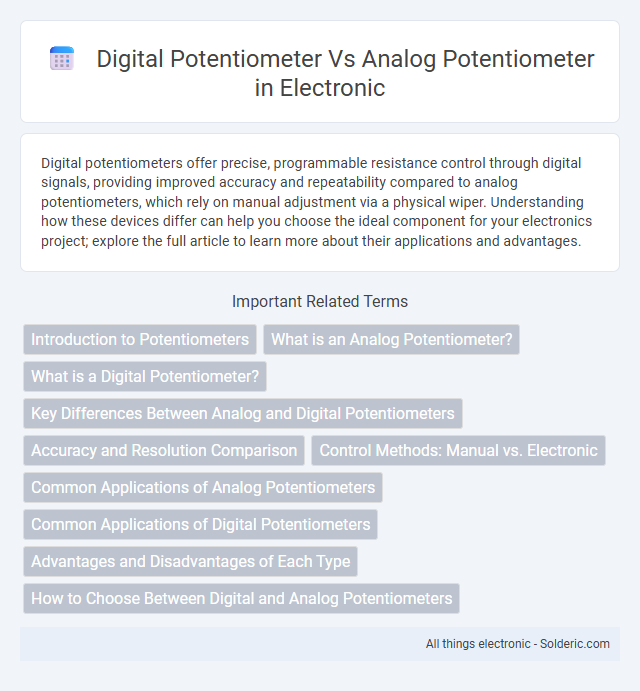Digital potentiometers offer precise, programmable resistance control through digital signals, providing improved accuracy and repeatability compared to analog potentiometers, which rely on manual adjustment via a physical wiper. Understanding how these devices differ can help you choose the ideal component for your electronics project; explore the full article to learn more about their applications and advantages.
Comparison Table
| Feature | Digital Potentiometer | Analog Potentiometer |
|---|---|---|
| Control Type | Digital (via SPI/I2C or up/down pins) | Manual mechanical adjustment |
| Resolution | Typically 8-10 bits (256-1024 steps) | Continuous variable |
| Precision & Repeatability | High repeatability, precise step increments | Subject to mechanical wear and tolerance |
| Size & Integration | Compact, integrates easily in circuits | Bulkier, manual component |
| Power Consumption | Low power digital control | No power required for resistance adjustment |
| Durability | Long lifecycle, no mechanical wear | Prone to mechanical degradation |
| Applications | Automated volume control, tuning, calibration | Manual adjustments in audio, instrumentation |
| Cost | Generally higher | Lower cost |
Introduction to Potentiometers
Potentiometers are variable resistors used to adjust voltage or signal levels in electronic circuits. Analog potentiometers rely on a physical wiper sliding over a resistive element to vary resistance, while digital potentiometers use electronic switches controlled by digital signals to achieve precise adjustments. Your choice between digital and analog potentiometers depends on factors like accuracy, programmability, and application requirements.
What is an Analog Potentiometer?
An analog potentiometer is an adjustable resistor used to control voltage manually through a wiper that slides along a resistive element, providing variable resistance. It operates through mechanical movement, allowing continuous adjustment ideal for applications requiring fine-tuning of voltage or signal levels. Analog potentiometers are commonly used in audio equipment, calibration devices, and user interfaces due to their simplicity and tactile feedback.
What is a Digital Potentiometer?
A digital potentiometer is an electronically controlled device used to adjust resistance in a circuit through digital signals rather than manual turning. It offers precise resistance settings via microcontroller interface, enabling automated and repeatable adjustments in applications like volume control, calibration, and signal conditioning. Your projects benefit from improved reliability and programmability compared to traditional analog potentiometers, which rely on mechanical movement.
Key Differences Between Analog and Digital Potentiometers
Analog potentiometers use a continuous resistive track to vary voltage manually through a mechanical wiper, offering smooth, infinite adjustment. Digital potentiometers employ discrete resistor ladder networks controlled electronically via digital signals, enabling precise, repeatable settings without mechanical wear. Key differences include mechanical versus electronic control, continuous versus stepwise resistance changes, and susceptibility to physical degradation versus improved durability and integration in digital circuits.
Accuracy and Resolution Comparison
Digital potentiometers offer higher accuracy and finer resolution than analog potentiometers due to their precise digital control and quantized steps, typically ranging from 64 to 1024 discrete positions. Analog potentiometers rely on mechanical adjustment, which can introduce variability and lower resolution tied to the physical wiper and resistive track. Your choice will impact the precision of voltage division or signal attenuation in applications requiring consistent and repeatable settings.
Control Methods: Manual vs. Electronic
Digital potentiometers utilize electronic control methods through digital signals, enabling precise and programmable resistance adjustments via microcontrollers or computer interfaces. Analog potentiometers rely on manual control, where a user physically rotates a knob or slider to vary resistance, offering straightforward but less precise adjustments. Electronic control in digital potentiometers allows integration into automated systems, enhancing accuracy and repeatability compared to the manual operation of analog counterparts.
Common Applications of Analog Potentiometers
Analog potentiometers are frequently used in volume controls, tuning circuits, and light dimmers due to their simplicity and reliable hand-adjustable resistance. They find application in calibrating sensors, adjusting signal levels in audio equipment, and providing user input in various consumer electronics. These devices also play a critical role in industrial control systems for setting parameters and fine-tuning analog signals.
Common Applications of Digital Potentiometers
Digital potentiometers are widely used in precision electronic applications such as adjustable gain control in amplifiers, automated calibration systems, and programmable voltage dividers. They offer advantages in remote control and integration with microcontroller systems found in audio equipment, sensor interfacing, and tuning circuits. Unlike analog potentiometers, digital versions provide enhanced reliability and repeatability, essential for applications requiring frequent adjustments and digital interface compatibility.
Advantages and Disadvantages of Each Type
Digital potentiometers offer precise, programmable resistance adjustments with improved repeatability and integration in automated systems, but they typically have limited resolution and are susceptible to digital noise interference. Analog potentiometers provide continuous, smooth resistance variation with simple operation and low cost, but suffer from mechanical wear, potential signal degradation, and limited lifespan. Choosing between them depends on the need for precision control versus tactile adjustment and durability in the application.
How to Choose Between Digital and Analog Potentiometers
Choosing between digital and analog potentiometers depends on your application's precision, control, and interface requirements. Digital potentiometers offer programmable resistance adjustments with high accuracy and integration ease in microcontroller systems, making them ideal for automated and repeatable settings. Analog potentiometers provide intuitive manual control and simple circuitry, suitable for applications where tactile feedback and straightforward adjustments are necessary.
digital potentiometer vs analog potentiometer Infographic

 solderic.com
solderic.com